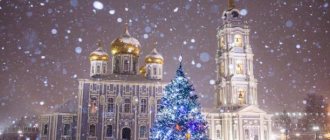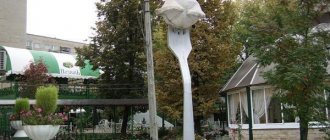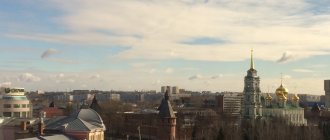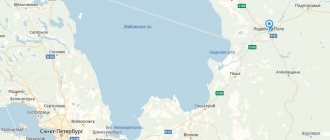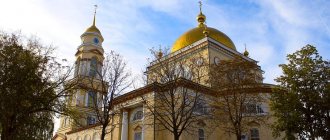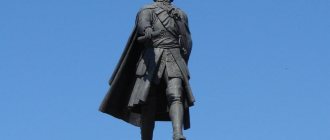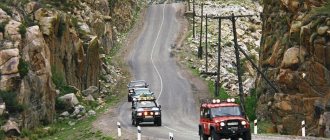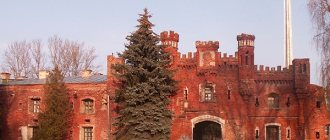In the very center of Tula, not far from the station, there is The main square of Tula is Lenin Square.
Here you will find the Tula Kremlin, the samovar museum, and an unusual city sculpture - a monument to the Tula gingerbread, which any tourist will definitely enjoy. There is a small nice park around it. In summer there is a large dancing fountain.
There is a shopping mall nearby where you can go to the movies and eat. But I don’t recommend buying anything else, as the prices here are quite high.
A square around the monument to the Tula gingerbread.
I definitely recommend checking out the samovar museum. There is a huge samovar that you can go into and, on the contrary, a completely drip samovar - a souvenir. There are a variety of samovars here, the same ones are real from Tula. Both ancient and from the times of the USSR - with images of Lenin and Stalin. A lot of unusual and simply beautiful rare dishes.
Samovar Museum and Tula Kremlin in the evening.
If time permits, go to the territory of the Tula Kremlin, to the shopping arcades - here you will definitely find Tula souvenirs to your liking. There are museums on the territory of the Kremlin - a torture museum in one of the Kremlin towers and a weapons museum in the building of a former church. You can book a tour of the Kremlin walls.
But I recommend leaving time for the large weapons museum - the one located on Oktyabrskaya Street.
Just behind the Kremlin, the beautiful Kazan embankment recently appeared. There are benches for relaxation and a cafe on the embankment. The pedestrian street Metallistov runs parallel to it. Along the street you will find the Museum of Soviet Toys, a very small sculpture of a Tula artisan and a monument to a policeman.
If you have little time, but want to see more on your own and see the main places of Tula in 1 day or less, then it will be enough to visit Lenin Square, its attractions, the samovar museum and the central park.
Tula residents nicknamed the large museum of weapons “helmet”, since the building is made in the form of this armor. Here you will see unusual exhibits - for example, a revolver weighing 3 grams that can fire. This museum has a shooting range, a library, interactive screens, and an open-air exhibition of military equipment.
Tula Museum of Weapons “from the wrong side”, the undress side.
Having driven a little up Oktyabrskaya Street from the “helmet”, you can get to the small exposition of the exotarium. Here you will be greeted by the famous Tula “mother-in-law”. This is how Tula residents affectionately call the interesting sculpture of a tyrannosaurus, which is located at the gates of the exotarium.
The exotarium also has a large exhibition in Central Park, but only here you can see the Lemon pig-tailed macaque, gray owl, toucan, long-eared fennec monkeys and other interesting animals. On weekends, demonstration feedings are held here at 11:00 and 16:00.
Attention! Monday and Tuesday are sanitary days in the old exotarium exposition, and Monday in the new one.
History of the region
In the 4th century AD e. The territory of the modern Tula region was inhabited by the Balts, and four centuries later they were replaced by the Vyatichi. In 1382, the region was annexed to the Moscow Principality. For some time, different princes fought for the cities of Dedoslavl, Belev, Novosil, Aleksin and Venev. As a result of civil strife in 1432, all Tula settlements came under the rule of the rulers of Ryazan.
View of the Tula Kremlin
Several centuries ago, the region was located on the southern outskirts of Moscow, so it performed defensive functions. Residents of the Tula lands have long defended the capital from attacks by the Golden Horde and Crimean Tatars.
In 1929, in connection with state reform, the Tula province received the status of a district, and 8 years later it was transformed into a region. Since then, its borders have remained virtually unchanged.
View of the buildings of the Spaso-Preobrazhensky Monastery in Belev
From the center of Moscow to the center of Tula is 185 km. It is only natural that the Tula region is experiencing a large merger of a wealthy metropolis. Today it is the most economically developed region of our country. Almost 1.5 million people live here. Local residents work in enterprises, in agriculture and forestry, in transport, in construction and willingly receive tourists.
"Spark"
Next on our list is the urban space “Iskra”. There are all kinds of bars, restaurants and cafes for every taste and budget. For example, you can try Neapolitan-style pizza in one place or in a tea shop you can take tea brewed with herbs from the Tula region and a real Ankovsky pie.
But in addition to all kinds of establishments, it is also very beautiful here. In the evening, the illumination is turned on, and the entire space is filled with warm lamp light. Another spot to take some cool photos.
The most interesting cities
Most travelers come to see the regional center. Tula
famous for its traditions of arms production, sweet gingerbread and samovars.
The Tula Kremlin
, ancient temples and architectural monuments of the 18th-19th centuries have been preserved in the ancient city
Mother of God Shcheglovsky Monastery in Tula
In addition to Tula, Aleksin is considered an interesting place for excursion tourism. One of the ancient Russian cities was founded in 1326. Travelers are attracted by the Old Assumption and New Assumption Cathedrals, St. Nicholas Church, wooden sculptures of fairy-tale characters in Zhalka Park and the local history museum, which operates in the house of the Maslov merchants.
It is interesting to visit Belyov, a small town on the left bank of the Oka, which traces its history back to 1147. Ancient monasteries and a historical center with buildings from the 18th-19th centuries have been preserved here. For its beauty and monuments, Belev is included in the list of 115 historical cities in Russia.
Holy Dormition temple complex in Aleksin
Bogoroditsk, founded in 1663, is called Tula Peterhof. In a small town there is a palace and park complex built by order of Catherine II for the empress’s illegitimate son, Count Alexei Bobrinsky.
In addition to the palace, there is a green park in Belevo, which is very pleasant to walk in.
Tula Kremlin
www.museum-tula.ru
Let's start the journey with the main attraction of the city - the Tula Kremlin. Here you can not only take a walk and look at the Kremlin from the inside, but also organize an excursion. You can choose from several guided sightseeing tours or view the exhibitions located in the atrium. And after the excursion into history, don’t forget to stop by the souvenir shop for traditional sweets or a samovar (where would we be without it!).
Kulikovo field
The famous Kulikovo Field is located 140 km southeast of Tula. It was in this place that a great battle took place in 1380, as a result of which Russia was freed from the yoke of the Golden Horde.
View of the memorial complex “Kulikovo Field” on Red Hill (Temple of St. Sergius of Radonezh and obelisk)
In a historical place there is a memorial column of Dmitry Donskoy and a temple-monument to Sergius of Radonezh. In the village of Monastyrshchina there is a museum where weapons and samples of military ammunition of those times are collected.
Weapons museum
www.museum-arms.ru
The old Museum of Weapons was located right in the Kremlin, but in 2012 a new building was opened, which you will see anyway - it’s hard not to notice the building in the shape of a huge helmet. We highly recommend taking a tour, especially if you don't know the difference between a musket and a Kalashnikov assault rifle. There they will tell you about the visit of Peter I in 1712 (he decided to open an arms factory in Tula), and about the legendary TT pistol, and about the master Lefty, who shoed a flea, and about anti-aircraft installations. In general, it’s fascinating even for pacifists.
Yasnaya Polyana
Fans of Russian literature are regulars at Yasnaya Polyana. The ancient estate of Lev Nikolaevich Tolstoy is located in the Shchekinsky district, 15 km from Tula and 199 km from Moscow.
Buses, minibuses and taxis go there from the regional center.
View of L.N.'s house Tolstoy at the Yasnaya Polyana estate
Tula province is the writer’s birthplace and the place where he lived for more than 50 years. The memorial museum displays antiques, furnishings, books, manuscripts and photographs of Tolstoy and his family. On the edge of a ravine, in the forest, there is a modest grave of the writer.
Polenovo
Not far from Tarusa, on the high bank of the Oka, there is a beautiful estate of the outstanding master of landscape - Vasily Polenov.
In addition to the three-story white house, the memorial complex includes the artist’s studio, outbuildings, the Trinity Church in Bekhovo, a garden, a manor park and the meadows and forests surrounding Polenovo.
View of the main house of the museum-estate of V.D. Polenova
Natural attractions
The Tula region is famous not only for its historical monuments, ancient monasteries and temples. There are many natural wonders and protected areas here.
The unique reserve “Tula Zaseki” was founded on the place where the Zasechnaya Line passed many centuries ago. By the will of the Moscow princes, in order to protect the southeastern borders of the state, the forest was specially cut down, resulting in impassable jungle.
Source of the Don River
Today, the reserve is home to many animals and birds, and a special ecosystem has developed. Tula Zaseki has excellent forest air, beautiful views and plenty of opportunities for walking. The center of the conservation area is located in the village of Krapivna, where a colorful nettle festival is held every year.
To see the source of the Don River, it is worth coming to the Children's Park of Novomoskovsk. One of the greatest rivers in Russia bakes from a small spring. The source is marked by a large boulder and a sculpture of two children on horses.
View of the Romantsevskie Mountains (Konduki)
It is curious that in the flat Tula region you can admire the “mountain” landscapes. The Romantsevskie Mountains are located near the village of Konduki, near the city of Bogoroditsk - in the east of the region.
Rocky massifs up to 200 m high are waste clay dumps. In the middle of the last century, brown coal was mined here, but then the quarries were abandoned. Now the bizarre slopes with deep cracks are overgrown with forest and separated by small turquoise lakes.
Kon-Kamen near the village of Kozye, Efremovsky district
In the city of Aleksin, on the high right bank of the Oka, there is a luxurious pine forest. Thanks to fertile soils and a temperate climate, pine trees look beautiful. More than 80% of trees are 120-140 years old. The undergrowth contains birch, linden, aspen, hazel, juniper, honeysuckle, serviceberry and alder, and several species of Red Book plants grow on the edge of the Aleksinsky Forest.
The Tula region is located in the forest-steppe part of the Central Russian Plain, so areas of feather grass steppes flourish here. The hilly area with limestone outcrops near the village of Kozye, in the Efremovsky district of the region, looks especially impressive.
The slopes on the right bank of the Krasivaya Mecha River occupy 15 hectares and are protected as a natural monument.
House-Museum of I. A. Bunin in Efremovo
Interesting places in Efremov
Efremov is a city that began its existence in the 18th century. It has many cultural monuments and a large number of natural attractions.
One of the features of the city is the city grove. This is the largest stand of trees in the area. This grove was planted by the merchant Nechaev, who was extremely concerned about the condition of his native city. He spared no expense in purchasing seedlings and planted them himself. During the war, this grove served as an excellent shelter for partisans.
The city has a house-museum dedicated to the work of Ivan Bunin. The museum has been actively functioning since the beginning of the 21st century. There are many rooms here containing items that belonged to the great writer.
In the city you can visit the Rubber Museum. Here, experienced guides conduct tours in which they talk about such an amazing material as rubber, its importance for people and industry, and its areas of use. In the halls of the museum, various samples of material are presented, which you can get to know better - you are allowed to touch and photograph them.
Souvenirs
What to bring from the Tula region? According to tourists' reviews, souvenir No. 1 is glazed Tula gingerbread. Tula residents have been producing printed gingerbread on an industrial scale and baking it in private bakeries since the 17th century.
The tasty delicacy has a spicy taste and a sweet filling made from jam or condensed milk.
Souvenir gingerbread cookies are a real work of culinary art. They are made from premium flour with the addition of honey and butter. Gingerbread cookies with inscriptions and images of local attractions are popular among travelers. Tourists eagerly buy delicious souvenirs in gift wrapping and large gingerbread cookies that weigh 4-5 kg.
Museum of the Matrona of Moscow in the village. Sebino
Popular sweet souvenirs include Venev bagels, Belev pastila and candies made at the Suvorov Factory. In Tula cities they sell chocolate figurines in the form of a bust of Leo Tolstoy and silhouettes of the Tula Kremlin.
Travelers like large and small samovars. Now in the Tula region they produce electric, wood-fired samovars and combined models. Tourists often buy small painted samovars, which are ideal for intimate tea parties.
View of the main house of the Bogoroditsky palace and park ensemble
If you like folk crafts, pay attention to Filimonovsky clay toys, sonorous Tula accordions, birch bark and wood crafts, Belevsky lace and ceramics from Yasnaya Polyana clay. The products of Tula gunsmiths are in particular demand - beautifully decorated souvenir knives, key rings and small figurines in the form of guns.
